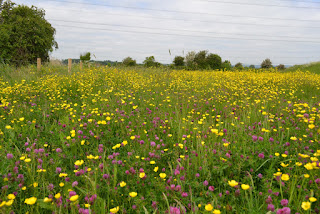This
was a day of bridges. And if it were
not bridges it would have been pylons.
We caught a train from Newport to
Caldicot, from which we walked beside the railway a little while, before
turning down to the bank of the Severn over
the M4 motorway. The embankment took
us back under the M4 again just where the bridge over the Severn
began. The vegetation was rough
grassland and not of interest, except a pool with Brackish
Water-crowfoot. Hemlock Water-dropwort
is one of the most common plants all along this coast and here we found a
striking black-and-yellow caterpillar on it: the larva of the Dingy Flat-body
Moth Depressaria daucella, whose
British distribution appears to mirror that of its food-plant. Eventually we reached the east end of the village of Sudbrook,
where the railway (at its west end) goes into a tunnel beneath the Severn,
delivering trains to London and Cheltenham. We
passed the rudimentary remains of the C12th church of Holy Trinity,
most of which has fallen into the estuary (human bones from the graves are
apparently sometimes washed ashore). Continuing
along the edge of the estuary we came to a park-like area, where we had a
view of two lave-net fishermen wading out into the Severn
across a channel between the shore and a rock area known as Lady Bench
exposed only at low tides. They walked
gingerly across the swift waters to lower their nets into the main stream to
trap salmon. The low cliffs here are
of Old Red Sandstone. From here we
bordered a saltmarsh area, the last bit of coast on the Wales Coast Path,
where we could say goodbye to Sea Club-rush, English Scurvy-grass and Sea
Milkwort. We walked inland through
improved meadow, colourful nonetheless with Red Clover and Meadow Buttercup,
up St Pierre Pill. We skirted a
golf-course (where inadequate signing led to us having to talk to a local
golfer about how to refind our path) and on through more fields (rather more
docile cows than heretofore) to the village of Mathern. At the end of the
village we crossed more fields to the edge of the M48 motorway and eventually
to a paved way to a tunnel underneath the major junction where the Severn Road
Bridge leaves across both the Wye
estuary and the Severn. The tunnel walls were painted by members of
a youth project with skilful graffiti referring to features of the area, such
as walking, fishing and cycling. We
were then at the edge of Bulwark, a southern suburb of Chepstow, with
occasional views of the second Severn
bridge. A garden escape here appeared
to be Cambridge Cranesbill Geranium x
cantabrigiense with prominent projecting stamens. The path then led along the east edge of
Chepstow through woodland and some industrial areas with views over the Wye,
which was largely brown mud because of the low tide. A celebratory statue of a leaping salmon
brought some silvery illumination into the gloom of the trees. We stopped for a snack on a seat with a
view over the Wye to Sedbury, where we could see where we had started the
Offa’s Dyke walk 13 years ago. After
passing a massive old quarry we walked through more woods where there was an
educational trail, including a dramatic spider's web stretched across a tall
Ash tree. We entered Chepstow through
the remains of medieval walls with guard turrets, climbing up and then down
streets towards the central area to Station Road and a large Tesco’s, before
crossing the main road by St Marys Church into the centre at Beaufort Square,
where we could find a place for coffee and a Post Office for sending American
postcards (for which we had been waiting for almost a week, as the path never
went anywhere near such a facility). We
then walked past the castle, down to the Information Centre to check the
exact whereabouts of the start (end) of the official coast path. This was just round a corner beside the
River Wye. There was a circular plaque
in the ground to mark it, surrounded by a stone circle, with a magnificent
backdrop of the Wye and cliffs opposite, and the third and fourth bridges, over
the Wye by road from Chepstow to Sedbury, and, close by, a railway
bridge. We had now completed the whole
Wales
coast. We walked to the station for a
train back to Newport,
and celebrated in the gardens of the Newbridge-on-Usk hotel where we were
staying, drinking Pimms seated in the sunshine and watching Salmon jumping in
the Usk below. We thought back to the
features of the day, one of which was a Jay, flying out of trees and crossing
our path, and another was along the path beside Chepstow when, after a
scurrying noise as of something being chased, a Grey Squirrel leapt over our
heads from a garden fence on our left and into the trees on the other side of
the path. As to the longer view, the
sense of achievement of having walked the whole coasts of England and Wales, parts of which will look
different now from when we passed them years ago, as the coast is always
changing, was mixed with a little melancholy to think that this particular
saga is over. The greatest impression
has been the huge variety of natural and human history we have been
privileged to encounter.
|
Pylons, Portskewett
Depressaria daucella caterpillar
|




























No comments:
Post a Comment